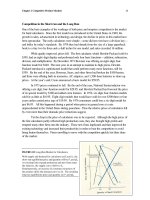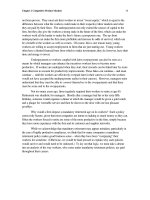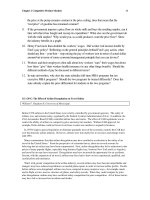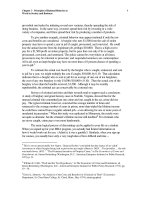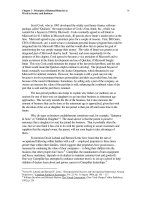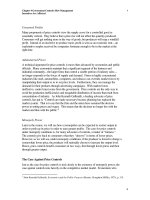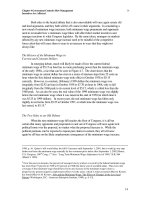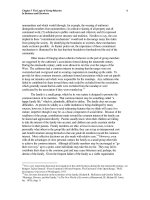Tài liệu Microeconomics for MBAs 15 ppt
Bạn đang xem bản rút gọn của tài liệu. Xem và tải ngay bản đầy đủ của tài liệu tại đây (41.9 KB, 10 trang )
Chapter 5 The Logic of Group Behavior
In Business and Elsewhere
9
nonmembers and which would (through, for example, the wearing of uniforms)
distinguish members from nonmembers; (4) collective sharing of all property and all
communal work; (5) submission to public confession and criticism; and (6) expressed
commitment to an identifiable power structure and tradition. Needless to say, the cost
implied in these “commitment mechanisms” would tend to discourage many free riders
from joining the society. By identifying the boundaries to societies, these mechanisms
made exclusion possible. As Kanter points out, the importance of these commitment
mechanisms is illustrated by the fact that their breakdown foreshadowed the end of the
community.
Other means of bringing about collective behavior on the part of group members
are suggested by the cattlemen’s associations formed during the nineteenth century.
During the nineteenth century, cattle were allowed to run free over the ranges of the
West. The cattlemen had a common interest in ensuring that the ranges were not
overstocked and overgrazed and in securing cooperation in rounding up the cattle. To
provide for these common interests, cattlemen formed associations which sent out patrols
to keep out intruders and which were responsible for the roundups. Any cattleman who
failed to contribute his share toward these ends could be excluded from the association,
which generally meant that his cattle were excluded from the roundup or were
confiscated by the association if they were rounded up.
13
The family is a small group, which by its very nature is designed to promote the
common interest of its members. That common interest may be something called “a
happy family life,” which is, admittedly, difficult to define. The family does not escape
difficulties. At present its validity as a viable institution is being challenged by many
sources; however, it does have several redeeming features that we think will cause it to
endure, imperfect though it may be, as a basic component of social fabric. Because of the
smallness of the group, contributions made toward the common interest of the family can
be shared and appreciated directly. Parents usually know when their children are failing
to take the interest of the family into account, and children can easily ascertain similar
behavior in their parents. Family members are able, at least in most cases, to know
personally what others in the group like and dislike; they can set up an interpersonal cost-
and-benefit structure among themselves that can guide all members toward the common
interest. Most collective decisions are also made with relative ease.
14
However, even
with all the advantages of close personal contact, the family as a small group often fails
to achieve the common interest. Although all family members may be encouraged to “go
their own way” up to a point, some individuals may take this too far. They may fail to
contribute their share to the common goal and may cause bitterness and, perhaps, the
demise of the family. Given the frequent failure of the family as a viable organization
13
For a very interesting historical investigation of the cattle business during the late nineteenth century, see
Rodgers Taylor Dennen, “From Common to Private Property: The Enclosure of the Open Range,” Ph.D.
dissertation, University of Washington, 1975.
14
See, for more discussion on the economics of the family, Richard B. McKenzie and Gordon Tullock,
“Marriage, Divorce, and the Family,” in The New World of Economics (Homewood, Ill.: Richard D. Irwin,
Inc. 1978), chap. 8
Chapter 5 The Logic of Group Behavior
In Business and Elsewhere
10
with a common interest,
15
the failure of much larger groups to achieve their expressed
common objectives is not difficult to understand.
Large Groups
In a large-group setting, the problems of having individual members contribute toward
the development of the common interest are potentially much greater. The direct,
personal interface which is present in small groups is usually lacking in larger groups;
and, by the nature of large groups and the public good they produce, the benefits
generated by any one person are generally spread over a large number of people, so much
so that their actions have a significant effect on anyone, even themselves. As a result,
they may perceive neither direct benefits in terms of what their behavior does for
themselves, personally, nor indirect benefits in terms of what their behavior contributes to
the welfare of others.
On the other hand, an individual may be able to detect benefits from his actions,
but he must weigh these benefits against the costs he may have to incur to achieve them.
For a large group the costs of providing detectable benefits can be substantial—or they
can escalate with the size of the group. This is not only because there are more people to
be served by the public good,
16
but also because large groups are normally organized to
provide public goods that are rather expensive to begin with. Police protection, national
defense, and schools are examples of very costly public goods provided by large groups.
If all people contribute to the public good, the cost to any one person can be slight; but
the question confronting the individual is how much he will have to contribute to make
his actions detectable, given what all the others do.
In the context of a very large group, suppose there are certain common national
objectives to which we can all subscribe, such as a specific charitable program. It is, in
other words, in our “common interest” to promote this program. Will people be willing
to voluntarily contribute to the federal treasury for the purpose of achieving this goal?
Certainly some people will (as Harry does in Figure 5.1 with a marginal cost of MC
2
)
,
but
many people may not. As they do each April 15 (the deadline for filing tax returns), most
will contribute as little income tax as possible. Under a system of voluntary
contributions, some people will contribute nothing. A person may reason that although
he agrees with the national objective, or common interest, his contribution—that which
he can justify—will do little to achieve it. He can also reason that withholding his
contribution will have no detectable effect on the scope and effectiveness of the program.
(If you or your parents did not pay taxes, would the level of public goods that benefit you
15
Approximately one-third of all families based on the institution of marriage end in divorce. Many others
fail, in terms of the presence of intense hostility, even though there is no legal recognition of that fact.
16
For a pure public good, the costs, by definition, do not rise with a few additional members. However,
most groups provide services that are less than a pure public good. Education is an example of an impure
public good; all education does not benefit all members of society simultaneously and to the same degree.
Under these circumstances, the costs can rise, as we have suggested, with the membership, although by a
lower percentage.
Chapter 5 The Logic of Group Behavior
In Business and Elsewhere
11
be materially affected?) It is for this reason that compulsory taxes are necessary. Olson
writes:
Almost any government is economically beneficial to its citizens, in that
the law and order it provides is a prerequisite to all civilized economic
activity. But despite the force of patriotism, the appeal of the national
ideology, the bond of a common culture, and the indispensability of the
system of law and order no major state in modern history has been able to
support itself through voluntary dues or contributions. Philanthropic
contributions are not even a significant source of revenues for most
countries. Taxes, compulsory payments by definition, are needed.
Indeed, as the old saying indicates, their necessity is as certain as death
itself.
17
The general tenor of the argument also applies to contributions that go to CARE, a
voluntary charitable organization interested mainly in improving the diets of
impoverished people around the world. Many of the students reading these pages have
been disturbed by scenes of undernourished and malnourished children shown in
television commercials for CARE. All those who are disturbed would probably like to
see something done for these children. They have had an opportunity to make a
contribution, but how many people ever actually contribute so much has a dollar?
Needless to say, many do give. They are like Harry in Figure 5.2, who is willing to dig,
voluntarily, some of the weeds from his yard. On the other hand, we emphasize the point
that a large number of people who have been concerned never make a contribution. (It
would be an interesting classroom experiment to see how many students are disturbed by
the CARE commercials and how many have ever given to the organization.) There are
many reasons for people not giving, and we do not mean to understate the importance of
these reasons; we mean only to emphasize that the large-group problem is one significant
reason.
True, if all members of a large group make a small contribution toward the common
interest, whatever it is, there may be sizable benefits to all within the group. But, again,
the problem that must be overcome is the potential lack of individual incentives form
which he collective behavior must emerge. Through appropriate organization of group
members, the common interest may be achieved, even if the membership is large. This,
however, merely shifts our attention to the problem of developing that organization. The
organization of a large group can be construed as a public good, and there are likely to be
costs to making the organization workable. This is likely for two reasons: first, there are
a large number of people to organize, which means that even if there is no resistance on
the part of the people to be organized, there will be costs associated with getting them
together or having them work at the same time for the same objectives. Second, some
individuals may try to “free-ride” on the efforts of others, which means it will cost more
to get people to become members of the group. Further, each free rider implies a greater
burden on the active members of the group. If everyone waits for “the other guy to take
the initiative,” the group may never be organized. It is because of the organization costs
17
Olson, Logic of Collective Action, p. 13
Chapter 5 The Logic of Group Behavior
In Business and Elsewhere
12
that students complain so often about the instructional quality of the faculty or some other
aspect of university life without doing anything about it. This is also why most people
who are disgruntled with the two major political parties do not form a party with those
who share their views. The probability of getting sufficient support is frequently very
low, which is another way of saying the expected costs are high.
Because an organization may appear to be an obvious way to promote the public
good, individuals who try to organize people for that purpose may go through a learning
experience before they conclude that it is too costly a venture for them. Even if the
organization is successful, the success may be temporary. Eventually, the free-rider
problem emerges and the group may fall apart. During the winter of 1973-74, the United
States was in the midst of an “energy crisis.” Prices of gasoline and other fuels were
being held down in spite of the limited imports of fuel coming into the country from the
Middle Eeast. Truckers were having a difficult item obtaining adequate supplies of diesel
fuel and of passing their higher operating costs through to the buyers of truck services.
Independent truckers sensed that it was in their common interest (not the public’s, of
course,) to halt their deliveries of goods and services and, in that way, put pressure on the
authorities to increase rates and to allocate more fuel supplies for the use of truckers. The
call for cooperation met with some success; some truckers did terminate operations and
some caught headlines by blocking traffic on major highways. However, there were
many unwilling to go along with the work stoppage—something that was in their
common interest. Consequently, the supporters of the work stoppage resorted to
violence, and it was the threat of violence, and not the common interest, which kept many
truckers off the road. If it had not been for the violence and the initial willingness of state
police departments to allow truckers to flaunt the law by stopping traffic, including other
truckers, it is very doubtful that the truckers would have had as much success as they did.
Qualifications to the Economic Theory
Obviously, there are many cases in which people acting in what may appear to be rather
large groups try to accomplish things that are in the common interest of the membership.
The League of Women Voters during the mid-1970s pushed hard for passage of the
Equal Rights Amendment. To the Constitution; labor unions work for wage increases;
and the American Medial Association does lobby for legislation that is in the common
interest of a large number of doctors. Churches, the Blood Mobile, and other charitable
groups are able to work fairly effectively for the “public interest,” and several of the
possible explanations for this observed behavior force us to step outside the scope of the
public goods theory.
Why may people work for the “public interest”? First, as Immanuel Kant, an
eighteenth century philosopher, said they should, people can place value on the act itself
as distinguished from the results or consequences of the act. The act of making a
charitable contribution, which can be broadly defined to include picking up trash in
public areas or holding the door for someone with an armful of packages, may have a
value in and of itself. This is true whether the effects of the act are detectable to the
individual making he charitable contribution or not. The personal satisfaction (or value)
Chapter 5 The Logic of Group Behavior
In Business and Elsewhere
13
that comes form the act itself is probably the dominant reason why some people do give
to CARE. To the extent people behave in this way, the public good theory loses force.
Notice, however, that Olson, in formulating his argument, focused on rational economic
man as opposed to moral man, envisioned by Kant. We expect that as the group becomes
larger, greater effort will be made to instill people with the belief that the act itself is
important.
Second, the contribution that a person has to make in group settings is often so
slight that even though the private benefits are small, the contribution to the common
interest is also small and can be a rational policy course. This may explain, for example,
student membership in groups like the National Association of Student Teachers. All one
has to do in many situations like this one is show up at an occasional meeting and make a
small dues payment. Further, the private benefits of being with others at the meetings
and finding out what the plans are for the association can be sufficient incentive to
motivate limited action that is in the common interest.
Third, all may not equally share the benefits received by group members from
promotion of the common interest. One or more persons may receive a sizable portion of
the total benefits and, accordingly, be willing to provide the public good, at least up to
some limit. Many businessmen are willing to participate in local politics or to support
advertising campaigns to promote their community as a recreational area. Although a
restaurant owner may believe the entire community will benefit economically from an
influx of tourists, he is surely aware that a share of these benefits will accrue to himself.
Businessmen may also support such community efforts because of implied threats of
being socially ostracized.
Fourth, large organizations can be broken down into smaller groups. Because of the
personal contact with the smaller units, the common interest of the unit can be realized.
In promoting the interest of the small unit to which they belong, people can promote the
common interest of the large group. The League of Women Voters is broken down into
small community clubs that promote interests common to other League clubs around the
country. The Lions Club collectively promotes programs to prevent blindness and to help
the blind; they do this through a highly decentralized organizational structure. Political
parties are structured in such a way that the local precinct units “get out the votes.” The
surest way for a presidential contender to lose an election is to fail to have a “grass-roots”
(meaning small-group) organization. Churches are organized into congregations, and
each congregation is decentralized further into circles and fellowship groups. Most of the
work in the Congress is done in committees and subcommittees. Quiet often a
multiplicity of small groups is actually responsible for what may appear to be the activity
of a large groups. The decentralization that is so prevalent among voluntary groups tends
to support the economic view of groups
18
18
Admittedly, other explanations for decentralization can be made, one of which relates to diseconomies of
scale. That is, the organization just becomes technically less efficient as its size is expanded. The
economic theory of groups rests on the motivational aspect of large organizations, rather than on the
technical capabilities of the organization.

